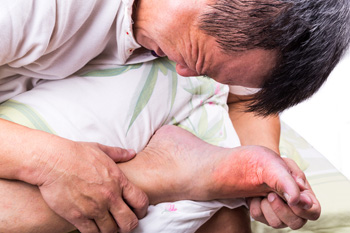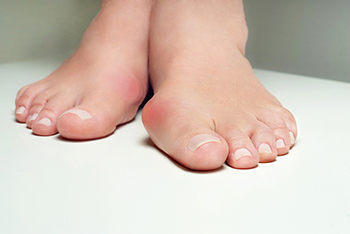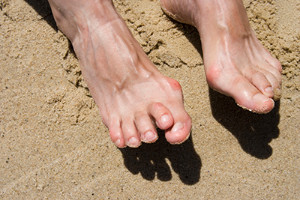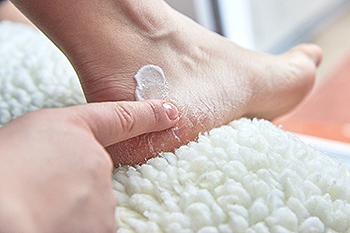January 2022
Causes and Symptoms of Gout
 When you experience a pain in the joint of your big toe that is accompanied by redness and swelling, you may have a condition known as gout. It is a form of arthritis caused by a buildup of urate in the blood. It ends up producing crystals that form in and around the joints, the most common of which is the joints of the big toe. During a gout flare-up the joint becomes tender, painful, red, hot and swollen. These symptoms can appear overnight, but may take about a week to recede. Gout is more common in older men, especially if they are overweight, eat fat-rich foods, and consume a lot of alcohol. If left untreated, gout can begin to form in other joints. If you think you may be having a flare-up of gout, it is wise to make an appointment with a podiatrist as soon as possible for a proper diagnosis and possible course of treatment.
When you experience a pain in the joint of your big toe that is accompanied by redness and swelling, you may have a condition known as gout. It is a form of arthritis caused by a buildup of urate in the blood. It ends up producing crystals that form in and around the joints, the most common of which is the joints of the big toe. During a gout flare-up the joint becomes tender, painful, red, hot and swollen. These symptoms can appear overnight, but may take about a week to recede. Gout is more common in older men, especially if they are overweight, eat fat-rich foods, and consume a lot of alcohol. If left untreated, gout can begin to form in other joints. If you think you may be having a flare-up of gout, it is wise to make an appointment with a podiatrist as soon as possible for a proper diagnosis and possible course of treatment.
Gout is a foot condition that requires certain treatment and care. If you are seeking treatment, contact Dr. Robert Graser from Graser Podiatry and Bunion Surgery Institute. Our doctor will treat your foot and ankle needs.
What Is Gout?
Gout is a type of arthritis caused by a buildup of uric acid in the bloodstream. It often develops in the foot, especially the big toe area, although it can manifest in other parts of the body as well. Gout can make walking and standing very painful and is especially common in diabetics and the obese.
People typically get gout because of a poor diet. Genetic predisposition is also a factor. The children of parents who have had gout frequently have a chance of developing it themselves.
Gout can easily be identified by redness and inflammation of the big toe and the surrounding areas of the foot. Other symptoms include extreme fatigue, joint pain, and running high fevers. Sometimes corticosteroid drugs can be prescribed to treat gout, but the best way to combat this disease is to get more exercise and eat a better diet.
If you have any questions please feel free to contact our office located in Boerne, . We offer the newest diagnostic and treatment technologies for all your foot and ankle needs.
Bringing the Hammer Down on Hammertoes
If you wear tight shoes that squeeze your toes together, you may be putting yourself at risk for developing a hammertoe. Hammertoes occur when there is an imbalance in the muscles, tendons, or ligaments which normally work together to hold the toe straight. This imbalance causes an abnormal bend in the toe’s middle joint, making it stick up, therefore the entire toe looks like the head of a hammer. Because the toe joint sticks up abnormally, it can rub against your shoes and cause a painful corn to develop at the site. It is important to seek treatment from a podiatrist as early as possible—before the hammertoe becomes rigid, and when the hammertoe is still flexible enough to be fixed. Your podiatrist may try taping the hammertoe to gently guide it back to its normal position or use toe pads or custom orthotics to cushion it. Some hammertoes may require corrective surgery to straighten it out. Make an appointment with a podiatrist as soon as you believe a hammertoe is forming on your foot, so you have a better chance of correcting the deformity.
Hammertoe
Hammertoes can be a painful condition to live with. For more information, contact Dr. Robert Graser from Graser Podiatry and Bunion Surgery Institute. Our doctor will answer any of your foot- and ankle-related questions.
Hammertoe is a foot deformity that affects the joints of the second, third, fourth, or fifth toes of your feet. It is a painful foot condition in which these toes curl and arch up, which can often lead to pain when wearing footwear.
Symptoms
- Pain in the affected toes
- Development of corns or calluses due to friction
- Inflammation
- Redness
- Contracture of the toes
Causes
Genetics – People who are genetically predisposed to hammertoe are often more susceptible
Arthritis – Because arthritis affects the joints in your toes, further deformities stemming from arthritis can occur
Trauma – Direct trauma to the toes could potentially lead to hammertoe
Ill-fitting shoes – Undue pressure on the front of the toes from ill-fitting shoes can potentially lead to the development of hammertoe
Treatment
Orthotics – Custom made inserts can be used to help relieve pressure placed on the toes and therefore relieve some of the pain associated with it
Medications – Oral medications such as anti-inflammatories or NSAIDs could be used to treat the pain and inflammation hammertoes causes. Injections of corticosteroids are also sometimes used
Surgery – In more severe cases where the hammertoes have become more rigid, foot surgery is a potential option
If you have any questions please contact our office located in Boerne, . We offer the newest diagnostic and treatment technologies for all your foot and ankle needs.
Finding the Right Running Shoe for Women With Bunions
 If you are a woman who loves to run, but also has bunions, it’s a good idea to reevaluate the type of shoes you are wearing. Tight shoes, especially pointed ones, can put pressure on the big toe joint and cause painful swelling. Qualities to look for in a running or workout shoe include, lightweight mesh uppers that provide comfort and allow the feet to breathe, a wide toe box that helps to accommodate the shape of a bunion, and a snug fit with proper cushioning. Preventative measures include stopping wearing high heels and pointed toe shoes, finding a bunion pad or sleeve to protect the area, and avoiding walking barefoot. In more serious cases, you may need to consult with a podiatrist who can help make custom orthotics and discuss other treatment options.
If you are a woman who loves to run, but also has bunions, it’s a good idea to reevaluate the type of shoes you are wearing. Tight shoes, especially pointed ones, can put pressure on the big toe joint and cause painful swelling. Qualities to look for in a running or workout shoe include, lightweight mesh uppers that provide comfort and allow the feet to breathe, a wide toe box that helps to accommodate the shape of a bunion, and a snug fit with proper cushioning. Preventative measures include stopping wearing high heels and pointed toe shoes, finding a bunion pad or sleeve to protect the area, and avoiding walking barefoot. In more serious cases, you may need to consult with a podiatrist who can help make custom orthotics and discuss other treatment options.
If you are suffering from bunions, contact Dr. Robert Graser of Graser Podiatry and Bunion Surgery Institute. Our doctor can provide the care you need to keep you pain-free and on your feet.
What Is a Bunion?
A bunion is formed of swollen tissue or an enlargement of boney growth, usually located at the base joint of the toe that connects to the foot. The swelling occurs due to the bones in the big toe shifting inward, which impacts the other toes of the foot. This causes the area around the base of the big toe to become inflamed and painful.
Why Do Bunions Form?
Genetics – Susceptibility to bunions are often hereditary
Stress on the feet – Poorly fitted and uncomfortable footwear that places stress on feet, such as heels, can worsen existing bunions
How Are Bunions Diagnosed?
Doctors often perform two tests – blood tests and x-rays – when trying to diagnose bunions, especially in the early stages of development. Blood tests help determine if the foot pain is being caused by something else, such as arthritis, while x-rays provide a clear picture of your bone structure to your doctor.
How Are Bunions Treated?
- Refrain from wearing heels or similar shoes that cause discomfort
- Select wider shoes that can provide more comfort and reduce pain
- Anti-inflammatory and pain management drugs
- Orthotics or foot inserts
- Surgery
If you have any questions, please feel free to contact our office located in Boerne, . We offer the newest diagnostic and treatment technologies for all your foot care needs.
Ways to Repair Cracked Heels
About one-fifth of adults in the United States experience cracked heels, studies show. Besides being unsightly, cracked heels that deepen can also become painful and lead to bleeding. Because there are no oil glands on the feet, they often become dried out. In addition, medical conditions such as diabetes, psoriasis and eczema can promote cracked heels. One of the simplest remedies for cracked heels is a petroleum jelly treatment. It helps reduce moisture loss from the skin and keeps it hydrated. Soak your feet in warm water for about 15 minutes, and then use a pumice stone to scrub off the dried skin. Rinse and pat dry thoroughly. Next, apply moisture lotion to the affected area and cover that with petroleum jelly to seal it in. Put on a pair of wool socks overnight and wash your feet again the next morning. If cracked heels continue to give you problems, it is suggested that you visit a podiatrist who can recommend further treatment options.
If the skin on your feet starts to crack, you may want to see a podiatrist to find treatment. If you have any concerns, contact Dr. Robert Graser from Graser Podiatry and Bunion Surgery Institute. Our doctor can provide the care you need to keep you pain-free and on your feet.
Cracked Heels
It is important to moisturize your cracked heels in order to prevent pain, bleeding, and infection. The reason cracked heels form is because the skin on the foot is too dry to support the immense pressure placed on them. When the foot expands, the dry skin on the foot begins to split.
Ways to Help Heal Them
- Invest in a good foot cream
- Try Using Petroleum Jelly
- Ease up on Soaps
- Drink Plenty of Water
Ways to Prevent Cracked Heels
- Moisturize After Showering
- Skip a Shower
- Keep Shower Water Lukewarm
- Don’t Scrub Your Feet
If you are unsure how to proceed in treating cracked heels, seek guidance from a podiatrist. Your doctor will help you with any questions or information you may need.
If you have any questions, please feel free to contact our office located in Boerne, . We offer the newest diagnostic and treatment technologies for all your foot care needs.
Blog Archives
- July 2024
- June 2024
- May 2024
- April 2024
- March 2024
- February 2024
- January 2024
- December 2023
- November 2023
- October 2023
- September 2023
- August 2023
- July 2023
- June 2023
- May 2023
- April 2023
- March 2023
- February 2023
- January 2023
- December 2022
- November 2022
- October 2022
- September 2022
- August 2022
- July 2022
- June 2022
- May 2022
- April 2022
- March 2022
- February 2022
- January 2022
- December 2021
- November 2021
- October 2021
- September 2021
- August 2021
- July 2021
- June 2021
- May 2021
- April 2021
- March 2021
- February 2021
- January 2021
- December 2020
- November 2020
- October 2020
- September 2020
- August 2020
- July 2020
- June 2020
- May 2020
- April 2020
- March 2020
- February 2020
- January 2020
- December 2019
- November 2019
- October 2019
- September 2019
- August 2019
- July 2019
- June 2019
- May 2019
- April 2019
- March 2019
- February 2019
- January 2019
- December 2018
- November 2018
- October 2018
- September 2018
- August 2018
- July 2018
- June 2018
- May 2018











